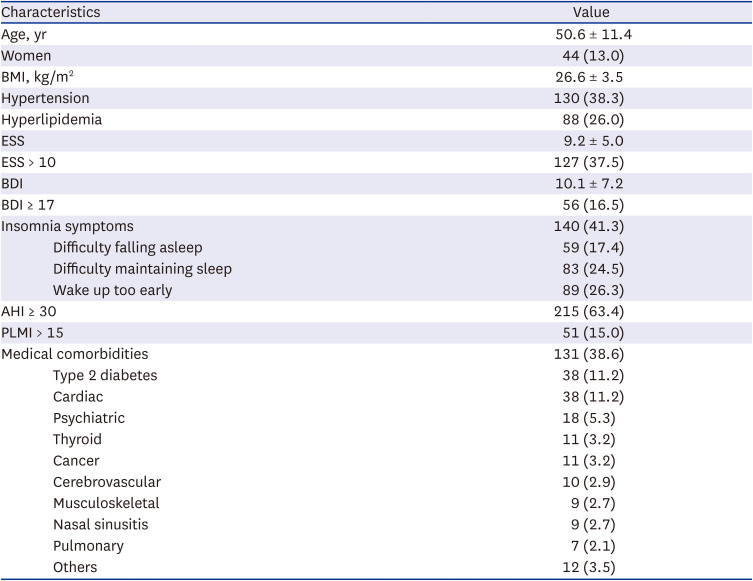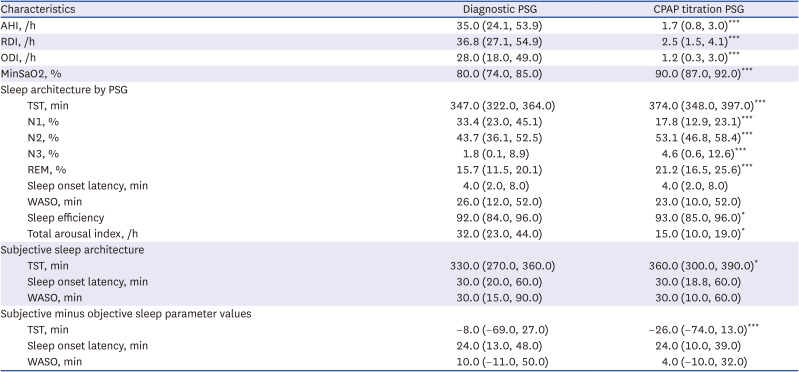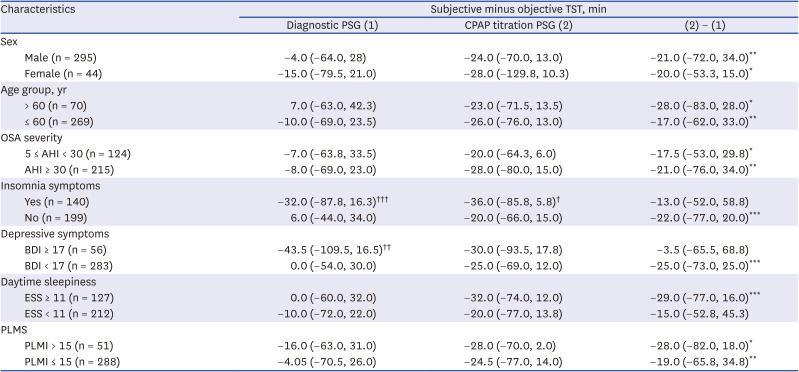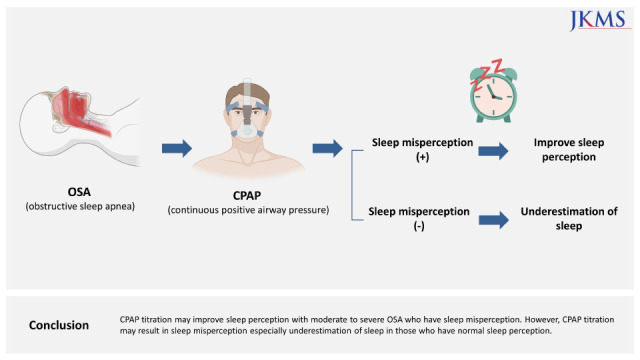1. Edinger JD, Krystal AD. Subtyping primary insomnia: Is sleep state misperception a distinct clinical entity? Sleep Med Rev. 2003; 7(3):203–214. PMID:
12927120.

2. Moon HJ, Song ML, Cho YW. Clinical characteristics of primary insomniacs with sleep-state misperception. J Clin Neurol. 2015; 11(4):358–363. PMID:
26256663.

3. Rezaie L, Fobian AD, McCall WV, Khazaie H. Paradoxical insomnia and subjective-objective sleep discrepancy: a review. Sleep Med Rev. 2018; 40:196–202. PMID:
29402512.
4. McCall WV, Turpin E, Reboussin D, Edinger JD, Haponik EF. Subjective estimates of sleep differ from polysomnographic measurements in obstructive sleep apnea patients. Sleep. 1995; 18(8):646–650. PMID:
8560130.

5. Nam H, Lim JS, Kim JS, Lee KJ, Koo DL, Lee C. Sleep perception in obstructive sleep apnea: a study using polysomnography and the multiple sleep latency test. J Clin Neurol. 2016; 12(2):230–235. PMID:
27074296.

6. Zhang Y, Ren R, Lei F, Zhou J, Zhang J, Wing YK, et al. Worldwide and regional prevalence rates of co-occurrence of insomnia and insomnia symptoms with obstructive sleep apnea: a systematic review and meta-analysis. Sleep Med Rev. 2019; 45:1–17. PMID:
30844624.

7. Bianchi MT, Williams KL, McKinney S, Ellenbogen JM. The subjective-objective mismatch in sleep perception among those with insomnia and sleep apnea. J Sleep Res. 2013; 22(5):557–568. PMID:
23521019.

8. Pinto LR Jr, Pinto MC, Goulart LI, Truksinas E, Rossi MV, Morin CM, et al. Sleep perception in insomniacs, sleep-disordered breathing patients, and healthy volunteers--an important biologic parameter of sleep. Sleep Med. 2009; 10(8):865–868. PMID:
19179110.

9. Castillo J, Goparaju B, Bianchi MT. Sleep-wake misperception in sleep apnea patients undergoing diagnostic versus titration polysomnography. J Psychosom Res. 2014; 76(5):361–367. PMID:
24745776.

10. Lee SA, Im K, Yang HR. Factors associated with sleep state misperception in patients with obstructive sleep apnea. Sleep Breath. 2022; 26(4):1921–1930. PMID:
35028861.

11. Fernandez-Mendoza J, Calhoun SL, Bixler EO, Karataraki M, Liao D, Vela-Bueno A, et al. Sleep misperception and chronic insomnia in the general population: role of objective sleep duration and psychological profiles. Psychosom Med. 2011; 73(1):88–97. PMID:
20978224.

12. Olaithe M, Bucks RS, Hillman DR, Eastwood PR. Cognitive deficits in obstructive sleep apnea: insights from a meta-review and comparison with deficits observed in COPD, insomnia, and sleep deprivation. Sleep Med Rev. 2018; 38:39–49. PMID:
28760549.

13. Buysse DJ, Germain A, Hall M, Monk TH, Nofzinger EA. A neurobiological model of insomnia. Drug Discov Today Dis Models. 2011; 8(4):129–137. PMID:
22081772.

14. Morisson F, Lavigne G, Petit D, Nielsen T, Malo J, Montplaisir J. Spectral analysis of wakefulness and REM sleep EEG in patients with sleep apnoea syndrome. Eur Respir J. 1998; 11(5):1135–1140. PMID:
9648968.

15. Harper RM, Kumar R, Macey PM, Ogren JA, Richardson HL. Functional neuroanatomy and sleep-disordered breathing: implications for autonomic regulation. Anat Rec (Hoboken). 2012; 295(9):1385–1395. PMID:
22851218.
16. Páramo-Brando AM, Durán P, Del Río-Portilla IY, Poblano A, Haro R. Differences in electroencephalographic spectra during pre-sleep wakefulness, N1, and R sleep between comorbid insomnia and obstructive sleep apnea. Sleep Breath. 2020; 24(1):267–275. PMID:
31797216.

17. Bianchi MT, Wang W, Klerman EB. Sleep misperception in healthy adults: implications for insomnia diagnosis. J Clin Sleep Med. 2012; 8(5):547–554. PMID:
23066367.

18. Kushida CA, Littner MR, Hirshkowitz M, Morgenthaler TI, Alessi CA, Bailey D, et al. Practice parameters for the use of continuous and bilevel positive airway pressure devices to treat adult patients with sleep-related breathing disorders. Sleep. 2006; 29(3):375–380. PMID:
16553024.

19. Berry RB, Brooks R, Gamaldo CE, Harding SM, Marcus C, Vaughn BV. The AASM Manual for the Scoring of Sleep and Associated Events: Rules, Terminology and Technical Specifications. Version 2.0. Darien, IL, USA: American Academy of Sleep Medicine;2012.
20. Kushida CA, Chediak A, Berry RB, Brown LK, Gozal D, Iber C, et al. Clinical guidelines for the manual titration of positive airway pressure in patients with obstructive sleep apnea. J Clin Sleep Med. 2008; 4(2):157–171. PMID:
18468315.
21. Cho YW, Lee JH, Son HK, Lee SH, Shin C, Johns MW. The reliability and validity of the Korean version of the Epworth sleepiness scale. Sleep Breath. 2011; 15(3):377–384. PMID:
20358406.
22. Lee YH, Song JY. A study of the reliability and the validity of the BDI, SDS, and MMPI-D scales. Korean J Clin Psychol. 1991; 10:93–113.
23. American Academy of Sleep Medicine. International Classification of Sleep Disorders. 3rd ed. Darien, IL, USA: American Academy of Sleep Medicine;2014.
24. Means MK, Edinger JD, Glenn DM, Fins AI. Accuracy of sleep perceptions among insomnia sufferers and normal sleepers. Sleep Med. 2003; 4(4):285–296. PMID:
14592301.
25. Choi SJ, Suh S, Ong J, Joo EY. Sleep misperception in chronic insomnia patients with obstructive sleep apnea syndrome: implications for clinical assessment. J Clin Sleep Med. 2016; 12(11):1517–1525. PMID:
27568893.
26. Mathieu A, Mazza S, Petit D, Décary A, Massicotte-Marquez J, Malo J, et al. Does age worsen EEG slowing and attention deficits in obstructive sleep apnea syndrome? Clin Neurophysiol. 2007; 118(7):1538–1544. PMID:
17507290.
27. Tamaki M, Nittono H, Hayashi M, Hori T. Examination of the first-night effect during the sleep-onset period. Sleep. 2005; 28(2):195–202. PMID:
16171243.

28. Byun JH, Kim KT, Moon HJ, Motamedi GK, Cho YW. The first night effect during polysomnography, and patients’ estimates of sleep quality. Psychiatry Res. 2019; 274:27–29. PMID:
30776709.
29. Vallières A, Ivers H, Beaulieu-Bonneau S, Morin CM. Predictability of sleep in patients with insomnia. Sleep. 2011; 34(5):609–617. PMID:
21532954.









 PDF
PDF Citation
Citation Print
Print




 XML Download
XML Download